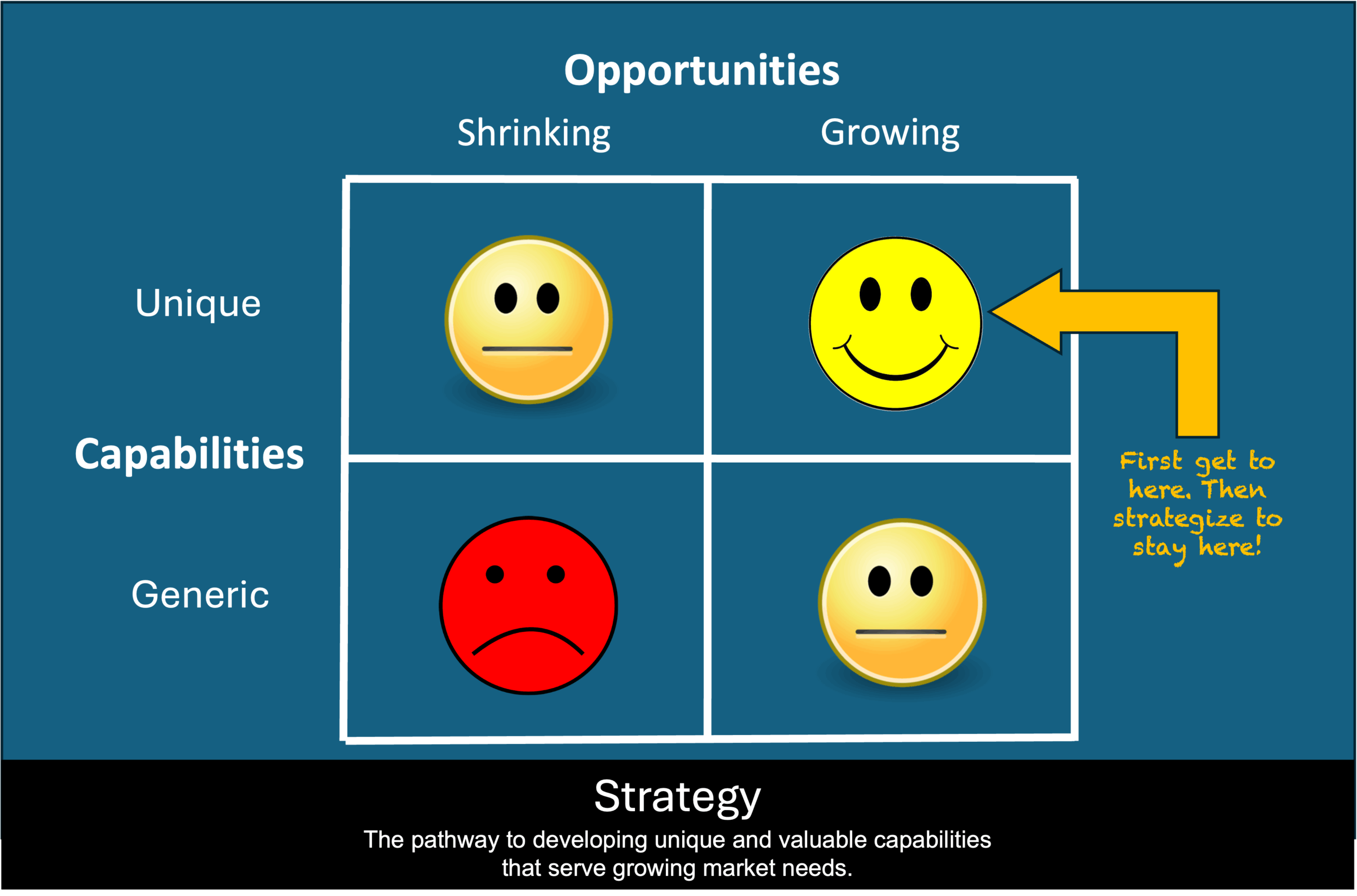Voila! Instant Strategic Insight
Summary Insight:
Most strategy fails by missing the obvious: future demand. Ask one question, cut through the noise, and steer with clarity—before the market makes the decision for you.
Key Takeaways:
- Demand is the single most important strategic factor—don’t ignore it.
- Misreading the environment leads to misaligned strategy and lost time.
- Shared frameworks like PESTEL help, but start with Demand first, always.
“Trying to predict the future is like trying to drive down a country road at night with no lights while looking out the back window.”
– Peter Drucker
When was the last time you got away from the office to take a good, long look at the trends that will likely impact your business, customers, and suppliers in the next five years?
I’m willing to bet that it’s been too long. With so many pressing demands on your time, energy, and focus right now, it can feel nearly impossible to step away from the day-to-day and invest some serious thought cycles in what might happen over the long term.
Of course, you already know that the best leaders and executives do actually invest the time and energy in thinking about and anticipating the future, and they do so on a regular basis. You also know from experience that, when you do step away from the day-to-day to really think, it turns out to be time very well spent indeed.
So what should you be thinking about when you’re doing strategic planning? MBA programs have something called a PESTEL analysis for strategic planning. With it, you look at what’s happening in the Political, Economic, Social, Technological, Environmental, and Legal environments and how anticipated changes will impact your business, customers, and suppliers. I can’t argue that these are reasonable sectors to examine and reflect on when thinking about your strategy. However, the PESTEL analysis also totally misses the most important factor to address!
When doing strategic planning, the most important question to ask is this: “DEMAND: Will there be more or less demand for what we do five years from now?” This is the most important question because, as I explain in detail in the book Organizational Physics: The Science of Growing a Business the goal of every business is to align unique capabilities with growing market opportunities (you want to be in top right “Happy” quadrant below):

(If you want to learn more about this diagram and how to integrate it into your planning, see Part III, Chapter 9 of my book: Organizational Physics: The Science of Growing a Business).
Never Misread the Environment
The greatest mistake a leader can make is to misread the environment. The reasons are self-evident. If, in the future, there’s going to be less demand for what you do now, then you need to be acting on this now to steer yourself into a growing sector. If you can’t find a growth sector, it’s just a matter of time until there’s no business at all. Or, if the environment zigs to a new growth opportunity, but you’ve zagged the company in the other direction, you’re pretty much out of luck. The environment trumps all, so you’ve got to pay attention and read it correctly.
Of course, there other important questions to ask when scanning the environment. To have a holistic, full-picture view of the environment, there are seven factors in all – including the most important one, Demand – that you need to examine when doing strategic planning:
| Demand | What changes are occuring within the market today that could siginificantly impact demand for your products and services, as well as how they are marketed and delivered, in the future? Are you weakly or strongly positioned to capitalize on these trends? |
| Competition | The competitive factors to consider are the number and capabilities of the perceived practical alternatives of the future. Will there be more or fewer competitors? Will they be stronger or weaker? How will your company differentiate itself in a crowded marketplace? |
| Economic | Economic factors to consider include consumers’ level of disposable income and overall economic confidence. Also consider the economic growth rate, the exchange rate, the inflation rate, and the unemployment rate. Will labor costs be higher or lower? What about the labor supply? |
| Regulatory | Some Regulatory factors to consider are laws relating to the environment, health and safety, antitrust, and labor. Also consider changes in the type of government, the level of political change vs. stability, and the amount of regulation/deregulation. How will tariffs, tax policy, and trade restrictions impact your business? Will there be more corruption or less? Will there be more bureaucracy and red tape or less? |
| Technological | Will the rate of technological change continue to increase? What emerging technologies now will radically shape the future? Will there be more automation or less? More complexity or less? More integration or less? How will these trends impact your business? |
| Ecological | The ecological environment is literally the planet that we all rely on for our sustenance and livelihoods. Will there be increasing or decreasing stress on the ecological environment in the future, and how will this impact your business? |
| Social | How will the population growth rate change? What about the age distribution in the markets in which you operate? What about health and community consciousness? Feelings of fear or safety? Societal infrastructures like healthcare and education? What about attitudes towards work and employment patterns? Attitudes towards certain companies or industries? Will any cultural taboos emerge or go away? |
Instant Strategic Planning
The hard part of strategic planning is that the needs of today always overpower the needs of tomorrow, so finding the time and energy to do strategic planning can feel like a luxury. The best way to do it is with a coach or someone outside the business who has an independent perspective and can reinforce a rhythm for doing it consistently.
Still, there will come crisis situations in your career when you need to instantly focus on the big picture. And guess what? The factor of Demand allows you to do a 1-question strategic assessment. Everything else can be considered a luxury.
For example, many years ago I was part of a board of directors that was trying to navigate an online advertising business through a stock market collapse. The company had just reached cash flow profitability and had a long and growing list of satisfied customers. At the same time, the stock market implosion was causing the entire country to feel panic and question the future. There was a low-ball offer on the table from a strategic acquirer. The board felt like the right thing to do was to take the offer.
When there’s panic and fear, it’s hard to see things clearly. I wish then that I had had the awareness to pierce the veil of fear and simply ask: “Hey guys, wait a minute. Sure, the stock market is collapsing but let me ask you this: Is there going to be more demand or less demand for online advertising in the future? If there’s going to be less demand, let’s exit this business. If there’s going to be more demand, then we should say ‘no’ to this offer and leverage our unique position and capture it.” I didn’t have that awareness then and we sold the business prematurely. But hey, at least I got some good learning and a blog post out of it.
You can learn from my mistakes and, the next time panic sets in, just take a moment to look at the long view and ask that one question: “Will there be more or less demand for what we’re doing in the future?” It will serve you well.




